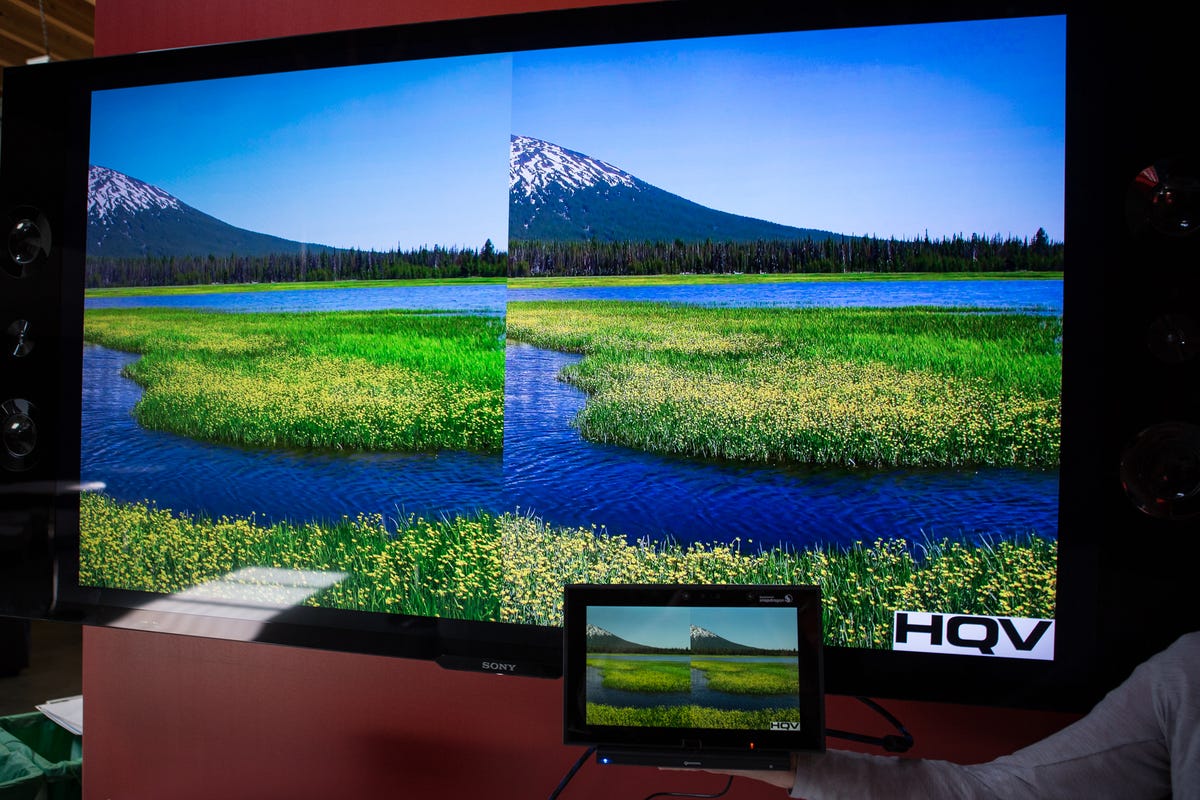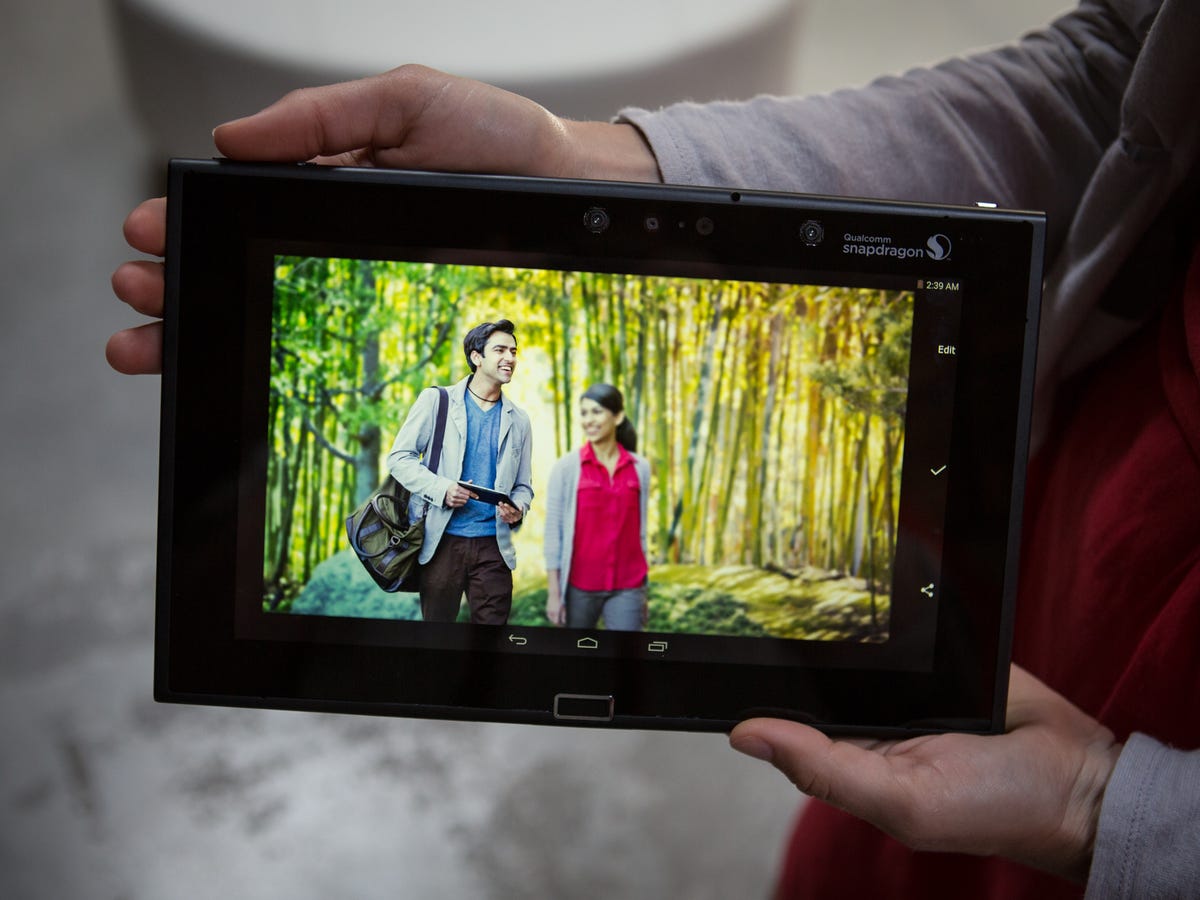
Josh Miller/CNET
SAN FRANCISCO — 4K resolution and video, neat-o photography effects, and gorgeous gaming. These are some of the benefits you’ll reap when your next phone or tablet comes with a Qualcomm Snapdragon 805 chipset inside, the successor to the 801 tucked inside the Samsung Galaxy S5 , HTC One M8 , and OnePlus One .
Qualcomm invited CNET and other mobile journalists for hands-on demos of reference tablets running on a Snapdragon 805 chip in a bunch of different scenarios. Here’s what you should expect.
1. Killer 4K screen
The 1,920×1,080p HD resolution that many of us are enjoying now on our 5-inch-or-larger smartphones and tablets is going to get better with a 4K resolution. Qualcomm showcased side-by-side images and video on a 10-inch tablet with a resolution of 3,840×2,160. The differences in colors and detail were much more subtle on the tablet than on the 65-inch Sony display, where colors look more vibrant and images — like blades of grass — are significantly more detailed.
2. Upscaling to your 4K TV
Ok, so you don’t have a 4K TV now, but one day you will. When you do, you’ll be able to treat your eyes to even crisper 4K photos, home videos, and Android games (for instance).
Behind the scenes, any videos you view that support the high-efficiency video codec H.265 will use the video processor on the Snapdragon 805 chipset to compress the file to half its size. The key here is that this is a hardware solution, not a power-hungry software process. As a device owner, you won’t notice a difference, unless it’s a small boost in battery life.
Sharper, clearer phone graphics? Meet Snapdragon 805 (pictures)






+7 more
3. Read clearer
Photos and graphics aren’t the only way to benefit from resolution. Icons, text, and fine lines will also appear even sharper, which is especially important when you zoom in on an image or read a text-heavy item on a large-screen tablet.
The best example showed a recipe on a 4K tablet side-by-side with a 1080p tablet. The clarity on the 4K tablet was striking compared to the 1080p tablet; I felt like I was getting an eye test and switching from the hazier resolution of my current prescription to a sharper resolution that revealed just how fuzzy I was.
There was just one problem: the 1080p tablet I saw had both the larger screen size (11 inches) and the lower resolution. Even if the larger screen had the same 4K resolution as its smaller cousin, it would already have a lower pixel density.
4. Get a gaming eyeful
To show off the new gaming capabilities inherent in the new Adreno 420 GPU that pairs with the Snapdragon 805 chipset, Qualcomm rolled out a favorite demo from Mobile World Congress. Called a hardware tessellation, you measure in terms of polygon units. The more there are, the more detail you get on objects large and small.
Compared to the image of the same hornet using the Adreno 330 GPU, this newer version is clearly superior. This, along with the higher resolution visuals, will translate into even richer gameplay. It’s again one of those things you may not notice it unless you’re holding two same-size devices side-by-side, but the win is that you feel even more immersed and wowed by the experience in your hands.
5. Do more with photos
Qualcomm had two really cool post-processing photo demos that will be especially useful on future smartphones that contain its chip (assuming that the OEMs take advantage of these capabilities, of course.)
The first does more with applying different focus points after you take the image. Think about the selective focus options on phones like the Nokia Lumia 1020 , Galaxy S5, and HTC one M8. You get your choice of two focal points — highlighting what’s near or what’s far.


Josh Miller/CNET
This new carryover from dSLRs takes a series of five pictures and lets you choose with a tap on the screen which “zone” you call into focus. An extra bonus in the demo was seeing how the particular image maps into the five zones — each photo produces its own depth map.
The second imaging demo shows a man and woman in front of a leafy background. Broad gestural strokes in green select the figures, and a stroke in red denotes the background. A few more taps later, the couple were in color and the background was in black and white. In another pass, the focus landed on one person and made the other (and the background) artfully blurred.
My favorite take-away here is that this software doesn’t require you to be exact about including all extremities and accessories; it’s smart enough to separate the subject from the background without you worrying about lopping off a hand. That’s very important for quick work with an imprecise fingertip.
6. Stream faster
The Snapdragon 805 happens to be the first of Qualcomm’s chipsets to use a modem that supports Cat 6 LTE, in other words, the Advanced LTE strain that can clock up to 300Mbps (it’s called the Gobi 9X35, if you’re curious.)
That, combined with carrier agreements that will allow compatible rivals to share bandwidth, should result in an even better, faster experience when it comes to streaming videos with little buffering. It’s up to the carriers to agree to this or not.
Just one thing to note — having a Snapdragon 805 chip doesn’t mean that you’ll automatically get the faster LTE. Like all these technological morsels, Qualcomm makes them available to device-makers, who can turn them them or not. The 805 processor also pairs with a different modem that delivers slower data speeds, which is better for markets that aren’t quite as LTE-developed.



